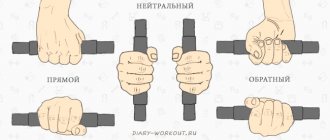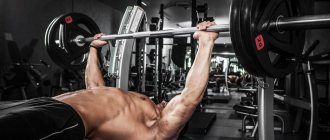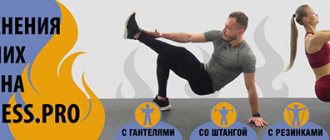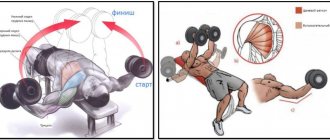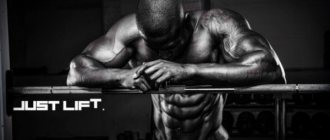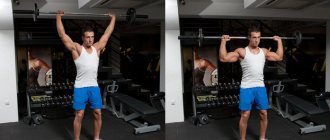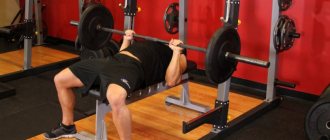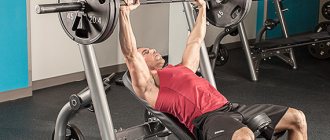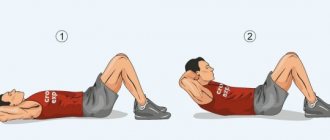Introduction[edit | edit code]
Training for the pectoral muscles
Surely, in the old fashioned way, you relied on the bench press and now every time you push to squeeze as much as possible. It is known in advance that the working weights in this exercise arrive slowly. It’s good if you manage to put on at least a couple of kilograms in a month. Why be surprised at the slow growth of breast mass? Meanwhile, bodybuilding is not about building a termite mound. Leave the painstaking work of many years to the ants. The breakthrough to the masses must be decisive, like a tank breakthrough! In other words, the science of winning has changed dramatically since the beginning of the new millennium. Today, the pecs are being massacred, and the bench press is being used as a last resort tool. In the first place is the complex rhythm of periodization, when one workout for the pectoral muscles is completely different from the other. The pectoral muscles each time receive a blow from an unexpected direction, and therefore the usual adaptation mechanisms, which in the past forced one to stagnate in one place for months, are powerless. To withstand the heavy fire of diverse power loads, it is not enough for the body to force the secretion of anabolic hormones. With a new training regimen, this tried-and-true lifesaver simply doesn’t have time to work. Well, therefore, the muscles pull out their last trump card from their sleeve, the existence of which until recently we knew absolutely nothing. We are talking about the activation of special anabolic genes. Thanks to science! She conducted countless experiments and finally discovered a way to attack the root cause of muscle growth - our genotype. Injections in the buttock are a thing of the past! Genes, or more precisely, periodization schemes, grow muscles faster than any steroids! So, according to the new recipe, you won’t recognize your breasts in the mirror in a month! In short, hurry up to jump on the bandwagon of the high-speed scientific express, and it will take you to your destination incomparably faster than the old gelding of the old method, which today can barely move its legs under you!
Incline dumbbell press[edit | edit code]
Dumbbell Incline Press
Start
: Place the bench at an angle of 30-45 degrees. Take a lying position on a bench. Spread your feet and rest their entire surface on the floor. Ask your partner to hand you dumbbells and hold them with your arms bent at your shoulders, turning them “in a line.”
Performance
: With a powerful, dynamic movement, press the dumbbells into straight arms. At the same time, do not bring them closer together, but press each one strictly vertically.
Attention!
At the top of the press, do not push the dumbbells together. keep them wide. this will maintain tension in the pectoral muscles and enhance their hypertrophy.
Do it efficiently!
: Dumbbells are usually pressed in arc trajectories, almost until they hit at the top point of the amplitude. Instead, press the dumbbells straight up. Imagine that you are pressing a barbell with your hands resting on the bar.
Training program
Pumping the pectoral muscle region using a barbell press with a reverse grip is performed according to the following scheme:
- 2 training sessions per week on Monday and Friday;
- maximum number of approaches – 4;
- the maximum number of repetitions in a set is 12;
- can be used in conjunction with the classic bench press in supersets;
- Duration of training without a long break is 10 weeks.
The reverse grip barbell press is recommended for athletes who experience discomfort when using dumbbells and lever exercise machines.
Bench press with reverse grip[edit | edit code]
Bench press with reverse grip
Attention!
Do not lower the barbell down until it touches your chest. When using a reverse grip, this can lead to injury to the shoulder joints.
Start
: Take a lying position on a barbell bench. Grasp the bar with an atypical reverse grip. To get a strong grip, you will have to grip the bar wide.
Performance
: Carefully remove the bar from the supports and slowly lower it down. Using a controlled, dynamic force, press the barbell into straight arms.
Do it efficiently!
: When performing a bench press with a reverse grip, the lifter usually keeps his elbows along his body. This method of performing the exercise helps to overcome greater working weight. Meanwhile, the purpose of the exercise is not to set strength records, but to transfer the load to the upper region of the pectoral muscles. To perform this task, you need to grab the bar wider and spread your elbows. In this case, the weight of the bar will objectively decrease, but the targeted load on the upper pectoral area will increase significantly.
Execution technique
The correct technique allows you to build muscle mass in the upper chest and front deltoids. The reverse grip press is done according to the following scheme:
- Hands are placed on the barbell shoulder-width apart, with the back of the hand pointing down. An open grip is not allowed. The finger locks the bar in the palm to minimize the risk of the bar slipping and falling on the face or other parts of the body.
- Feet are placed shoulder-width apart and rest on the floor surface.
- The weight is carefully removed from the racks and lowered to the chest as you inhale. Elbows are kept close to the body.
- The barbell is pressed all the way as you exhale and lingers at the top point for 2 seconds, after which it slowly lowers to the chest.
- Movements are performed smoothly. Sudden weight loss is prohibited as it creates a risk of injury.
To transfer the load to the lower chest, it is allowed to perform the exercise on an inclined bench downwards.
Inclined pullover[edit | edit code]
Inclined pullover
Attention!
Changing the angle of the bench changes the distribution of weight load between the back and chest in favor of the pectoral muscles.
Start
: Place an incline bench with the end facing the lower block. Attach a curved handle to the end of the pulley cable. Take a lying position on a bench. Ask your partner to give you the handle and hold it with straight arms above your head.
Performance
: Without bending your arms, lower the handle behind your head until you feel a strong stretch in your pectoral muscles. Using a powerful, dynamic force, return the handle to its original position above your head. At the end point of the lift, keep your arms strictly perpendicular to the floor.
Do it efficiently!
: Unlike traditional pullovers on a horizontal bench, this version of the exercise puts more stress on the pectoral muscles. Despite the reduction in the range of motion, the pecs contract more strongly, with the force accentuating their upper region.
Incline push press[edit | edit code]
Incline push press
Attention!
This exercise can only be performed safely using a Smith machine. do not forget to install the lower limiters.
Start
: Set the bench at an angle of 30-35 degrees. Place it under the bar of the Smith machine. Take a stable position on the bench. Spread your feet and rest their entire surface on the floor. Grasp the bar with a wide overhand grip. Remove the bar from the supports and lower it to your chest. Once again, check the correct position of the lower stops.
Performance
: Push the barbell upward with a powerful, dynamic force. The push should be so powerful that the bar gains momentum and flies above your hands. On the way back, catch the bar and slow it down. Lower the barbell under control to the starting position above your chest.
Do it efficiently!
: “Fast” fibers, responsible for explosive strength, have enormous hypertrophy potential, but at a slow pace of exercise, they are practically inactive. Forced activation of fast-twitch fibers through an explosive style results in rapid muscle growth. Performing explosive incline presses is physically impossible with a barbell and dumbbells. Only the Smith machine allows you to apply this unique training technique and powerfully stimulate progress in the lagging upper chest area.
Adviсe
To reduce the risk of injury, eliminate errors and obtain maximum results, you must adhere to the following tips:
- the weight of the barbell in a reverse grip should be less than the working weight in the classic version of the exercise;
- the anatomical features of the hands increase the risk of loss of control, so the presence of insurance from a partner is mandatory;
- the maximum permissible lower trajectory does not include the bar touching the chest;
- performing a reverse press is allowed in a Smith machine (in this case, additional insurance is not required);
- the exercise is auxiliary, therefore it is done in conjunction with the classic bench press and crossover raises;
- the stand should be at a height at which the hands reach the bar, being in a slightly bent position;
- It is prohibited to perform a reverse push press when the bar is pushed away from the body;
- a preliminary warm-up is carried out with an empty bar weighing up to 20 kilograms;
- to increase the load on the way up, lifting the weight is done quickly;
- standard load involves 3-4 approaches, each of which contains 8-10 repetitions;
- the bar must move strictly vertically without deviating from the trajectory (if the projectile moves towards the stomach, there is a risk of rupture of the deltas);
- When the elbows move to the sides, the load from the triceps moves to the back, and the pumping of the chest decreases.
There are no regulations regarding the sequence of performing the reverse grip press in the training program. The athlete himself decides whether to do the exercise before or after the main complex.
The reverse grip press is used for:
- lag in the development of the thoracic region compared to other muscle groups;
- presence of weak triceps;
- decreased performance from basic exercises.
The reverse press should not be performed by athletes with a shoulder, biceps or elbow injury. The exercise is not suitable for people who do not have flexible wrists. The reverse grip press is not recommended for beginners - due to the lack of experience in training with a barbell, the risk of the bar slipping out of your hands increases. If you follow the technique, the risk of injury from this exercise is minimal.
Sitting crossovers[edit | edit code]
Crossovers sitting
Attention!
To maximize the range of crossovers, bring the handles under your knees until they touch.
Performance
: Without changing the inclination of the body, move your hands in arcs under your knees. At the bottom point, take a short pause and slowly “release” the handles.
Start
: Place a low, short-back bench in the middle of the block frame. Sit on a bench and ask your partner to give you the handles of the upper blocks. Extend your arms straight to the sides. Lean forward strongly, almost until your chest touches your knees.
Do it efficiently!
: When performing crossovers in a standing position, the largest muscle groups of the body - the back and legs - take part in stabilizing the body. This scatters your strength and prevents you from fully concentrating on your pectoral muscles. The transition to a sitting position focuses all the stress on the chest. Thanks to this, crossovers acquire laser precision. Mental concentration is enhanced and helps increase the effectiveness of the exercise.
The intensity is higher![edit | edit code]
Use the following techniques to increase the intensity of your training in exercises marked with the following symbol: Hi. Use techniques only in the last two sets of the exercise.
- Forced repetitions (FR)
After “failure”, complete 2-3 additional repetitions with the help of a partner. It should help you overcome the short starting section of the amplitude. Next you must press the weight yourself.
- Peak contraction (PS)
At the end point of the amplitude, pause and hold the weight statically for 5 seconds. Achieve the most powerful static contraction of the pectoral muscles.
- Rest-pause (RP)
Choose a weight that you can do no more than 5-6 reps with. Do 2-3 reps, rest for 20 seconds and do another 2-3 reps. Again, rest for 20 seconds and do as many reps as you can. Rest again for 20 seconds and finish off the last few reps.
- Drop sets (DS)
Once you reach failure, reduce the working weight by 10-15% and do an additional set until failure. Next, again reduce the working weight by 5-10% and perform a new set until failure.
Source Muscle and Fitness Magazine No. 6
The best exercise for the chest is the head down press[edit | edit code]
The incline bench press is just as popular in gyms as the classic flat bench press. The bench press is often neglected, and, as a study conducted at Wayne State College showed, it is neglected needlessly.
The upside down bench press is a more effective exercise than the incline press in terms of muscle fiber recruitment.
The chest muscles consist of two parts: large - pectoralis major and small - pectoralis minor. This study looked at the effects of loading only on the pectoralis major muscle.
The pectoralis major, in turn, also consists of two parts: the upper, the muscle fibers of which are attached to the collarbone, and the lower, the fibers of which are attached to the sternum.
Bodybuilders who work the upper part of the pectoralis major muscle usually perform incline presses. Athletes whose task is to pump up the lower part of the muscle perform the bench press upside down.
To find out how both of these exercises affect hypertrophy, the researchers[1] recruited 15 men who had been training with weights for at least five years. The average age was 20 years, the average height was 184 cm, weight was 84 kg, and body fat percentage was 10%. All participants were required to do at least one bodyweight bench press to take part in the study. In laboratory conditions, athletes performed incline presses and overhead presses. The scientists measured electrical activity in the chest muscles during exercise.
The athletes performed the bench press in one set for six repetitions with a weight that was 70% of the one-time maximum. The bench angle for the incline press was 30 degrees; for the overhead press, the angle was 15 degrees below parallel to the floor. Each repetition was given 3 seconds.
Electromyography recorded the electrical activity of the muscles during the lowering and raising of the barbell. The size of the electrodes was 12 mm, the distance between the electrodes was 2.5 cm.
During the experiment, it was discovered that absolutely all 15 participants pressed more weight in the overhead press. The difference in maximum weight between the overhead press and the incline press averaged 20 kg. Electromyograph recordings showed that during the downward press, the participation of all pectoral muscles is greater compared to the incline press, and both types of press are equally effective for the upper chest. When it came to the lower part, electrical activity in muscle tissue was almost twice as high during the overhead press. This proves that variety of presses actually helps to hypertrophy different parts of the pectoral muscles (upper and lower).
Comment by Dmitry Yakovina
:
“A reasonable question arises. Based on the results of the study, the upper pectoral muscle contracts with the same tension in the incline press and the head down press. Why, then, in practice, do powerlifters, who bench, as a rule, with a bend in the lower back, thereby creating a trajectory of movement of the barbell similar to a head down press, have an undeveloped upper chest? It's actually simple.
The upper chest actually contracts during this process, which can be easily seen by feeling this area during the corresponding exercises or simply by looking at yourself in the mirror while performing the Standing Crossover exercise, in which the handles of the cables will move from top to bottom. However, the degree of contraction of the muscle fibers that are attached to the collarbones is very small.
While the muscle fibers of the lower part of the pectoralis major muscle work in almost full amplitude, since the direction of the vector of their contraction coincides completely with the direction of the vector of movement of the projectile, the fibers of the upper part do very little dynamic work, being most of the time in static tension, since the direction of these vectors coincides only partially.
The greatest expenditure of ATP occurs precisely during muscle fiber contraction, since ATP energy is required to break the myosin bridges sliding along the actin filaments.
Namely, energy expenditure leads to the appearance of growth factors such as free creatine and hydrogen ions in muscle fibers. Thus, a hypertrophy approach of 10-15 repetitions in an exercise targeting the lower chest does not induce optimal accumulation of growth factors in the fibers of the upper chest and does not stimulate protein synthesis to the maximum extent.
This situation can be compared to performing basic exercises, in which the main muscle group receives the maximum load and, accordingly, maximum growth, and the auxiliary muscles receive an indirect load.”
Bench Press Variations
If you do the same movement for a long time, the muscles get used to it and efficiency decreases. Vary your workouts with different variations of this exercise.
Bench Press with Dumbbell Reduction
This variation with a narrow grip, or as it is also called neutral, does a good job of loading the inner part of the pectoral muscle. It is very effective for building muscle mass in this area. The grip is a little different from the usual parallel grip. Here you will press dumbbells simultaneously and together, the total weight of the load can be slightly reduced.
How to do it:
- Hold dumbbells in both hands and set up as if you were doing a regular bench press. Press the dumbbells together throughout the exercise, feeling the tension in your arms.
- Raise the dumbbells until your arms are fully extended, and then lower them back to your chest. Keep bringing them together!
This variation can be performed either lying on a flat surface or on a bench with an adjustable incline.
One-arm dumbbell press
In this variation, you use only one dumbbell and work each arm separately. An excellent variation for pumping each chest separately and core stabilizer muscles. Among other things, you will have to strain very hard to maintain balance and the correct position.
How to do:
- Grab one dumbbell and get ready for a regular push-up. Place your feet firmly on the floor and tighten your abdominal muscles.
- Without changing the position of your shoulders and hips, lift the weight until your arm is fully extended, and then lower it again.
- Make the same amount on each side.
This variation can be performed either lying on a flat surface or on a bench with a different inclination.
Floor press
No bench?
No problem! Dumbbell presses can be done on the floor. This option is suitable for those for whom lowering the weight to the chest causes shoulder pain. How to do it:
- Lie on the floor with your knees bent and your feet flat on the floor. Raise the dumbbells above your chest.
- Bend your arms and lower them down to the floor. Repeat.
This exercise can also be performed with one dumbbell or with curled dumbbells.
Dumbbell press with alternating hands
This exercise not only allows you to work one arm at a time, but also improves coordination and core strength. This is a good exercise for muscular endurance and works well when used as part of a fat-burning workout.
How to do it:
- Take the starting position as with a regular variation. Hold one dumbbell close to your chest and lift the other up.
- Then raise your second hand while lowering the first.
- Continue alternating sides throughout the entire set.
The angle of the bench can be changed when performing this version of the press.
Dumbbell press on fitball
How to do it:
- Start sitting on a stability ball with dumbbells in both palms. Focusing on your feet, lean back until your entire back, shoulders and head are on the ball. Tighten your legs and core.
- Start the movement with your arms bent at right angles up until they are straightened, then lower them. Make sure to keep your hips and shoulders still and level.
On a fitball you can perform the variations described above.
